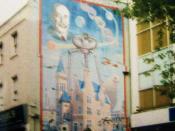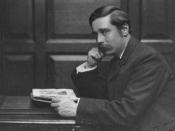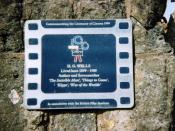Readers have certain expectations of a ghost story, they expect a well constructed atmosphere and obvious tension .H.G Wells does this skilfully using explicit descriptions that help to create a certain mood and atmosphere that makes the reader uncomfortable yet keeps them enthralled. Using detailed adjectives and word play creates a vivid picture in the readers mind filling them with trepidation and anticipation.
When the man is on his way to The Red Room, he claims, "The long, draughty subterranean passage was chilly and dusty."ÃÂ There is a lot of suspense as the reader is constantly anticipating some kind of terrible fright and tension because they know the red room is haunted/dangerous - they have been warned and they know something is going to happen because the young man has made it clear that he is anxious. The "living"ÃÂ shadows cause a feeling that the young man should always look behind his back and show he is not very confident.
There are four characters in the red room, the young man and the three grotesque custodians. The way they are described is as old, bent ancient, decaying and almost lifeless. This makes us feel quite uncomfortable .The constant repetition of "it's your own choosing"ÃÂ builds up mystery as the reader is wondering, what is his own choosing? Why do they keep saying that? Describing the other characters as "grotesque"ÃÂ separates them from the reader and therefore makes it hard for the reader to relate to them, it also creates a mood of distrust.The reader does not want to be surrounded by "grotesque"ÃÂ, "ÃÂold"ÃÂ, "ÃÂdecaying"ÃÂ, ugly people and H.G Wells creates the illusion that the reader is actually there "ÃÂ this is the effect of imagary and many adjectives, creating a vivid picture in the readers mind, letting their imagination fill in the unimportant parts, making the story much more dramatic and unique for every reader.
Distrust is also built up as the old woman recites "this night of all nights!"ÃÂ This phrase puts the reader on edge, asking, what is so special about tonight? Is it a full moon or anniversary of some kind the exclamation mark included adds to the effect The characters are also very anti-social, the old man stares at the young man's feet whilst talking to them, the man with the shade stares at him "askance"ÃÂ and they all stare at him together as he leaves for his challenge.
None of the three "grotesque custodians"ÃÂ hold eye contact for very long, in fact only the man with the shade looks into his eyes once the other two do not seem to look directly at him, maybe they have something to hide? There are no formal names mentioned in the story, creating mystery and making the reader more uncomfortable, - people always want to know the unknown "Are you really going ?"completes their conversation, showing the man with the shade really can't believe the young man is going to stay there, is he crazy? The old woman constantly stares into the fire as if she is thinking something sad or planning, this also creates mystery causing us to wonder what she is thinking about The setting is described as old, chilly, and ghostly, even though there is no spectre we are tricked into thinking there is something eerie about the place when really no ghost is there. Also the "long, draughty, subterranean passage was chilly and dusty " is an effective description of a horrible, cold and scary place where you don't want to be. This makes you increasingly uncomfortable, ready for the entrance into the red room where you reach the climax of the story. The setting comes across as very secluded, - giving the impression there is no-where to call for help.
The setting is not described as a friendly place "ÃÂ you don't want to be there, the place puts you on edge and the vivid picture created in your mind makes you feel almost part of the story, which is important for all of the language devices to work H.G Wells uses metaphors to create vivid images. A prime example of this is "an ocean of mystery " H.G Wells uses this to emphasise an almost endless amount of mystery beyond the darkness. "Island of light " is another good example of an effective metaphor "ÃÂ an island is usually small, compared to the rest of the world, this exaggeration helps the reader to understand just how dark it was in the room, and how miniscule and ineffectual the light is.
Repetition helps the statement or question to really get noticed, for example "Its your own choosing"ÃÂ. Personification is a good way of creating graphic pictures in the readers mind "ÃÂDo flames really dance? No but this is the classic image of hell."ÃÂ shutting of an eye"ÃÂ is very effective it suggests death or the end of someone or something, exactly what H.G.Wells wanted to show, the death of the dancing flames.
"a shadow came sweeping up after me and one fled before me into the darkness"ÃÂ the fleeing part suggests panic, and creates tension the fact that the shadows , despite being inanimate came after him fills you with horror, is there someone else around? it also shows that he has become hysterical and his imagination is running wild.The shadow is repeated , causing the feeling of a ghostly presence.
H.G wells uses many devices to create a tense atmosphere He does this sucessfully ,similies,metaphors,and repetion which combined help to make the reader feel part of the story if this is achieved the reader will be totally engrossed in the story ,. I think tension and suspense is the most important factor in a ghost story ,- without this there would not be a negative atmosphere and the reader would not be scared.





